Mystery Objects
This is a repost of items that have yet to be identified, the majority of them were sent in by readers of this site. Please let us know if you recognize any of them.
436. 9" tall to the top of the rods, this was among the items to be tossed out from an old municipal building in Pennsylvania.
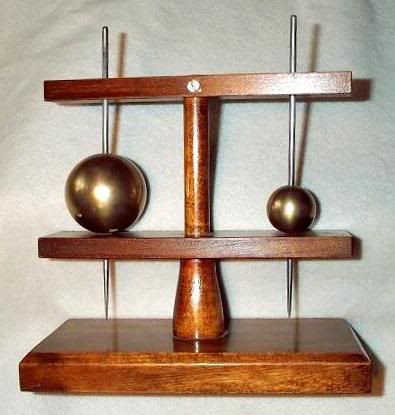
471. 5" diameter
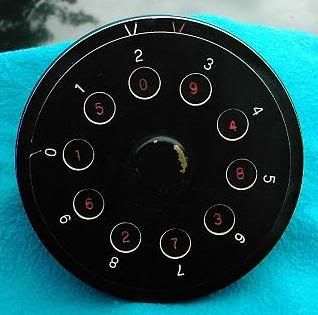
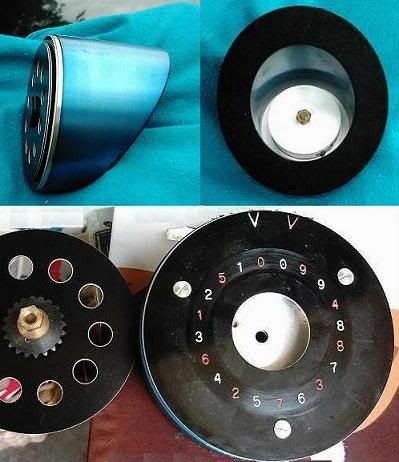
With faceplate removed:
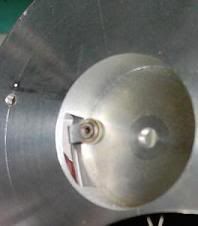
518. 46" long
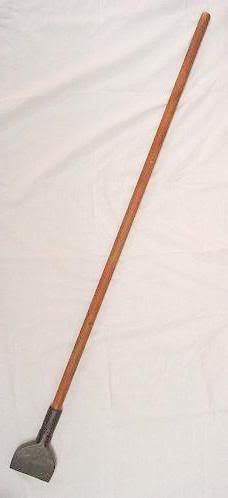
4" wide
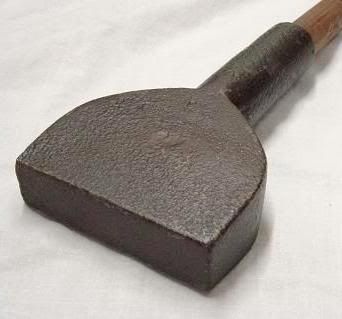
Thanks to Tom for sending in this catalog scan to help solve this floor rammer:
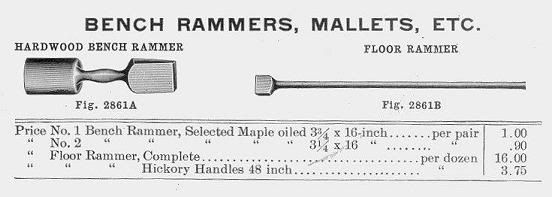
543. Found in an early home in upstate NY, the patent appears to be 18?? and is stamped on back of what looks like a tack hammer head. Overall length is 14 1/2", iron teeth strip is 12" L x 5/16" W, mounted on a 1/2" x 1" rectangular strip of wood (wood is nicely fluted on top).
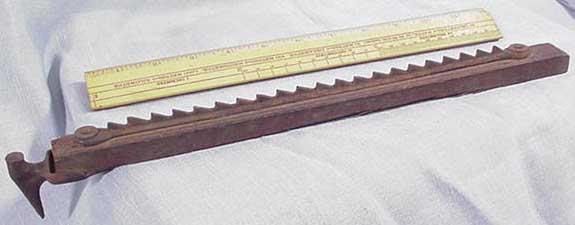
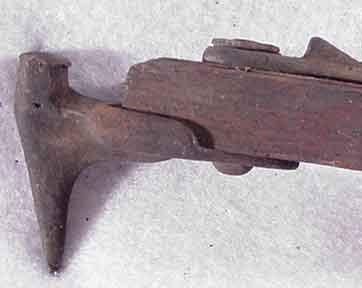
244. 2 1/4" diameter
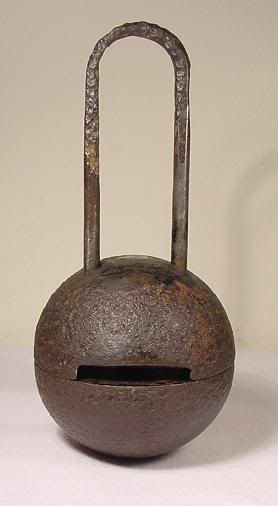
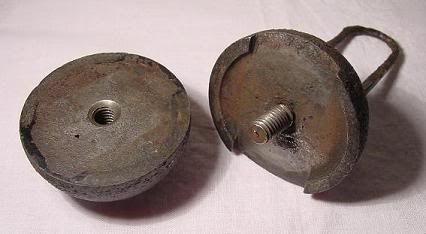
228. Please see the second post on this page for more photos of this one.
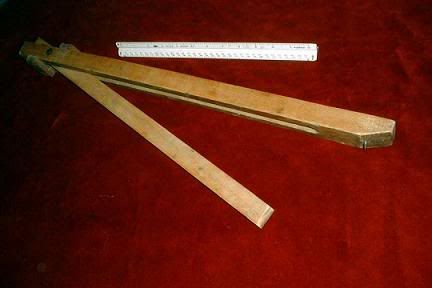
76. 5" tall
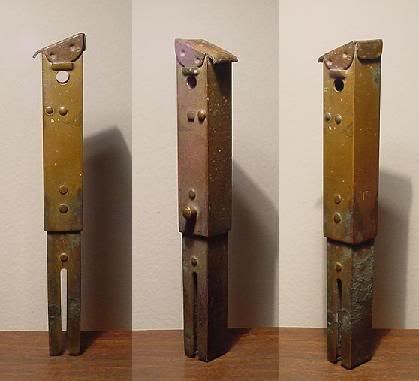
186. The top part of this tool can pivot all the way down to either handle. 13 1/2" long
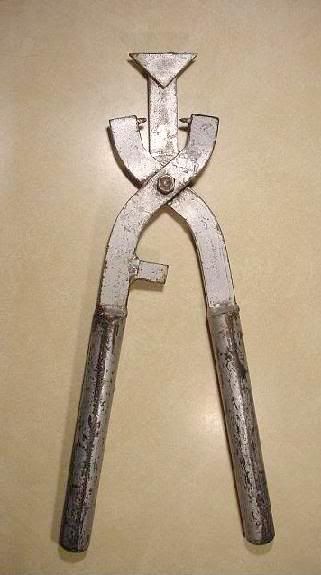
570. This might have been a good one to post on Halloween, the photos below were sent to me by someone who has had this box up in their attic for years, it measures 12” x 10” x 6”.
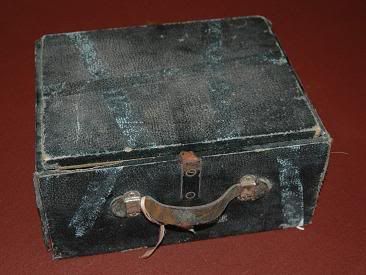
Answer: A Civil War era mortician’s facial reconstruction kit
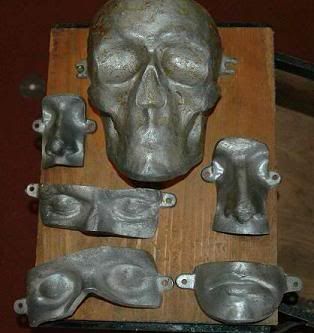
202. The frame is cast with the words "BATESON AUTO TOOL WKS ROME NY A1". The overall length is 20" from the end of the handle to the other end. It apparently mounts in a bench vise, there is a pad in the center of the C frame. The hand wheel adjusts the pad closer to the reamer/ spotface assembly. The button on the pad measures 1/2" and the reamer measures .505".

212. 6 1/2" long

246. 39" high, 8" wide
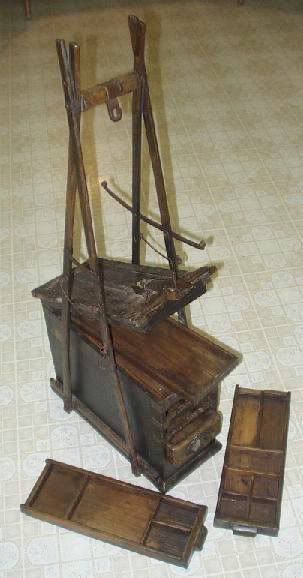
More pictures of this one
298. 8" long
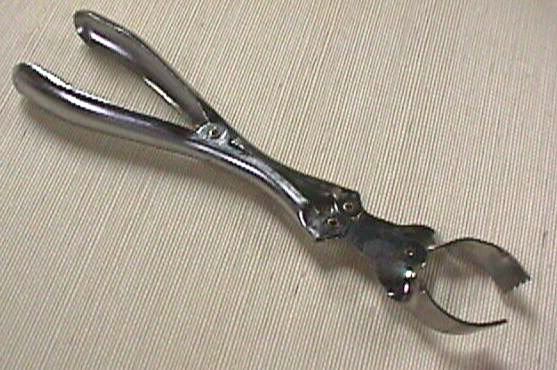
447. 19" long, made of light cast iron, this tool was found in the woods on the site of a former barn in the southern part of the province of Quebec. The barn was razed probably 80 to 100 years ago.
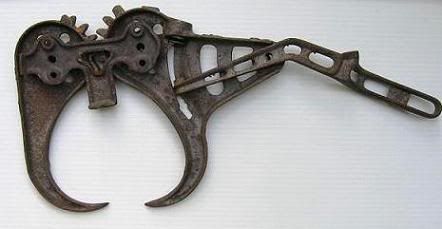
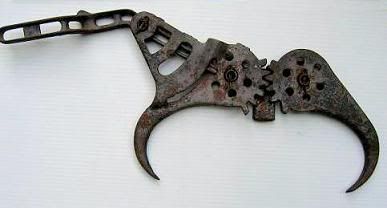
The distance between the two points in the photo above is 10-1/2".
Thanks to Dan for helping solve this one, it's a part of a one-man bucksaw, as seen in his photo:
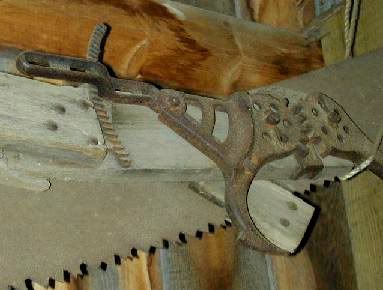
432. 9-1/2" long, marked "Royal" and "23 oz"
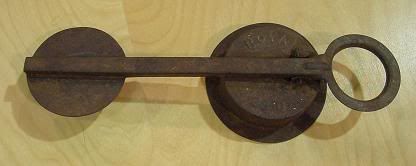
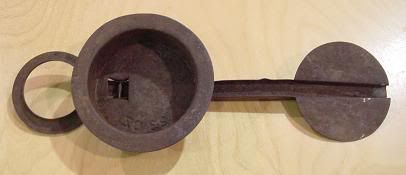
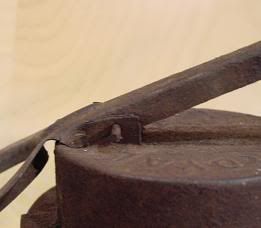
383. 12" long
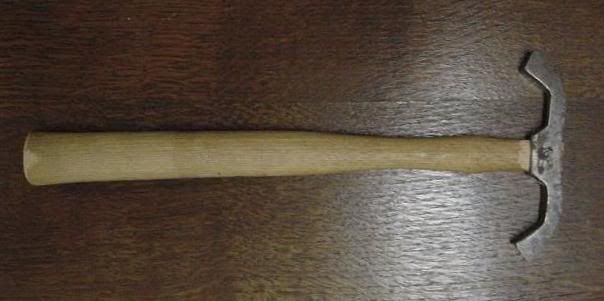
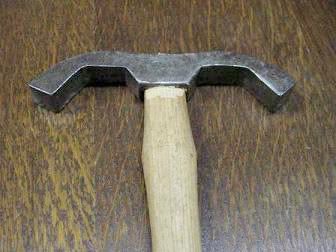
If you have a mystery item of your own that you would like posted here, feel free to email photos of it to me at the address listed under my profile. You can also submit unusual objects that are known, but that will be of interest to visitors of this site.
Back to the latest set of photos
436. 9" tall to the top of the rods, this was among the items to be tossed out from an old municipal building in Pennsylvania.

471. 5" diameter


With faceplate removed:

518. 46" long

4" wide

Thanks to Tom for sending in this catalog scan to help solve this floor rammer:

543. Found in an early home in upstate NY, the patent appears to be 18?? and is stamped on back of what looks like a tack hammer head. Overall length is 14 1/2", iron teeth strip is 12" L x 5/16" W, mounted on a 1/2" x 1" rectangular strip of wood (wood is nicely fluted on top).


244. 2 1/4" diameter


228. Please see the second post on this page for more photos of this one.

76. 5" tall

186. The top part of this tool can pivot all the way down to either handle. 13 1/2" long

570. This might have been a good one to post on Halloween, the photos below were sent to me by someone who has had this box up in their attic for years, it measures 12” x 10” x 6”.

Answer: A Civil War era mortician’s facial reconstruction kit

202. The frame is cast with the words "BATESON AUTO TOOL WKS ROME NY A1". The overall length is 20" from the end of the handle to the other end. It apparently mounts in a bench vise, there is a pad in the center of the C frame. The hand wheel adjusts the pad closer to the reamer/ spotface assembly. The button on the pad measures 1/2" and the reamer measures .505".

212. 6 1/2" long

246. 39" high, 8" wide

More pictures of this one
298. 8" long

447. 19" long, made of light cast iron, this tool was found in the woods on the site of a former barn in the southern part of the province of Quebec. The barn was razed probably 80 to 100 years ago.


The distance between the two points in the photo above is 10-1/2".
Thanks to Dan for helping solve this one, it's a part of a one-man bucksaw, as seen in his photo:

432. 9-1/2" long, marked "Royal" and "23 oz"



383. 12" long


If you have a mystery item of your own that you would like posted here, feel free to email photos of it to me at the address listed under my profile. You can also submit unusual objects that are known, but that will be of interest to visitors of this site.
Back to the latest set of photos

23 Comments:
246 : The famous Shinebox (from goodfellas?)
By Anonymous, at 1/19/2006 4:09 AM
Anonymous, at 1/19/2006 4:09 AM
447 : A log picker upper - Unless the Quebec comment is a red herring?
By Anonymous, at 1/19/2006 4:20 AM
Anonymous, at 1/19/2006 4:20 AM
568: Stanley #67 "Universal" spokeshave
By Anonymous, at 1/20/2006 8:20 AM
Anonymous, at 1/20/2006 8:20 AM
246 looks like an old art easel kind of thing.
By Lab Brat, at 1/20/2006 9:45 AM
Lab Brat, at 1/20/2006 9:45 AM
202 is very similar to a tool i have often used to fit new bushings on the kingpin spindles of straight axle front suspension common on vehicles from the beginning to the mid sixties.
By Anonymous, at 1/20/2006 10:35 PM
Anonymous, at 1/20/2006 10:35 PM
563. Fire extinguisher. These were usually filled with carbon tetrachloride and thrown onto a fire. The glass would break, releasing the carbon tetrachloride which would put out the fire.
By Anonymous, at 1/21/2006 12:12 AM
Anonymous, at 1/21/2006 12:12 AM
447 is a caliper.
By Anonymous, at 1/21/2006 2:58 PM
Anonymous, at 1/21/2006 2:58 PM
Two brass spheres(?) with rods through them on a stand tossed out from an old municipal building in Pennsylvania:
(Don't quote me on this) Judging from the photo, it looks to be made of brass and polished in circles around the axis of the rods- if thats right it's probably a resonator of some sort. If you strike (lightly) the end without the point it should give of a distinct tone (a bit like a tuning fork). Some can also be used to filter a collection of tones to detect if the note that the resonator is tuned to is present in the collection. Not of much practical use these days, but I get the impression they're rather rare. I'd hang on to it if I were you.
For more info look up: acoustic resonators/oscillators. Julius S Miller did a little demonstation on these back in the day.
By Anonymous, at 1/21/2006 10:53 PM
Anonymous, at 1/21/2006 10:53 PM
Thanks for the comments, I'll see if I can find more info to verify some of the guesses.
By Rob H., at 1/22/2006 3:33 PM
Rob H., at 1/22/2006 3:33 PM
543.
In reading other comments about this being a wire stretcher, I think people are mistaking the end of this tool as a hammer. I am sure it is a holding device, and the mushroomed surface was caused by hitting it witn a hammer to drive the pointed end into the fence post, giving you leverage.
By Canem, at 1/24/2006 6:23 AM
Canem, at 1/24/2006 6:23 AM
298. Charcoal tongs. My dad had a similar pair that he used to re-arrange hot coals in our Hibachi bar-b-q. His was an older model, with interlocking 'fingers'.
By Anonymous, at 1/24/2006 10:34 AM
Anonymous, at 1/24/2006 10:34 AM
566: A reading finger used by Monks or Preists to follow a line while they read in the ancient spripts. I doubt if it is Judiac in origin or use, because it has an image of an animal carved in it. These images (human or otherwise) are forbidden by one of the ten comandments.
By Anonymous, at 1/24/2006 7:03 PM
Anonymous, at 1/24/2006 7:03 PM
517: safe dial - when the correct numers ine up the safe will open two v grooves - one for setting the combination one for dialing the combination- much like modern day safe dial.
By Anonymous, at 1/25/2006 6:03 PM
Anonymous, at 1/25/2006 6:03 PM
>I am sure it is a holding device, and the mushroomed surface was caused by hitting it...
Sounds like a good possibility.
>298. Charcoal tongs...
One of the better answers I've heard on this one, I'll look into it.
>517: safe dial
Could be...
If I find anything to verify these or other guesses I'll post them on this page.
By Rob H., at 1/25/2006 6:15 PM
Rob H., at 1/25/2006 6:15 PM
186. looks like the tag pliers we used to use to put identification tags into a cow's ear.
By Anonymous, at 3/02/2006 3:56 PM
Anonymous, at 3/02/2006 3:56 PM
Hmmm, my over active imagination would like to believe that #570 is some sort of odd, bizarre kit to cover up a horrifying war wound or something similarly hideous. Perhaps to hide a hole in a face where a nose would be normally. Don't take that seriously.
By Anonymous, at 3/23/2006 4:14 PM
Anonymous, at 3/23/2006 4:14 PM
# 570 ... The secret may lie on the inside. I believe that these items are molds. One might pour a gel or plaster into each and see what the results look like.
By Anonymous, at 4/02/2006 2:37 PM
Anonymous, at 4/02/2006 2:37 PM
all very beautiful and sexy items!
By Vasilios Billy Mavreas, at 4/02/2006 9:08 PM
Vasilios Billy Mavreas, at 4/02/2006 9:08 PM
># 570 ... The secret may lie on the inside. I believe that these items are molds.
Here is a quote from the owner of these objects:
"They’re not really useful as “molds” because there’s no void on the other side into which you could pour some moldable substance. I guess they could be used to create molds, tho."
Best idea on these that I've heard so far is that they are a Civil War era mortician’s facial reconstruction kit, though I haven't been able to verify this or find any similar items.
By Rob H., at 4/03/2006 6:26 PM
Rob H., at 4/03/2006 6:26 PM
I saw something very similar to this item on a TV program by the british wilderness survival expert RAY MEARS. He was visiting (if memory serves) an inuit / eskimo tribe.
The item was use to run a rope between two holes sunk into a frozen lake, in order to pull through a fishing net. The device is pointed from one hole in the ice towards the other. Being made of wood it floats just under the surface of the ice. A rope attached to the free swinging arm is pulled rhythmically causing the arm to pivot, and in this way the device 'walks' itself under the ice towards the other hole.
Despite having seen the program several times re-run on the Discovery Science channel here in the UK, i can neither remember what its called, or find any relevant information about any similar devices in the internet.
Having looked at the pics again, it doesn't look like there are any attachment points for a rope or lanyard on the contraption. This means i am almost certainly wrong. However, at least you have another crackpot theory to add to your collection!
By Anonymous, at 4/04/2006 7:13 AM
Anonymous, at 4/04/2006 7:13 AM
oops, should have mentioned in above post, referring to item 228
doh!
By Anonymous, at 4/04/2006 7:14 AM
Anonymous, at 4/04/2006 7:14 AM
There has been a spate of enquiries on the net about a rare metal
plaque from ancient India called the KAILASHA DHANARAKSHA YANTRA
TALISMAN. Believed to have been created by Hindu Rishis, Buddhist
Lamas and Tantric shamans atop the holy Mount Kailash following a
twelve year period of ritual fasting, this appears to be an authentic
item from the past considering the degree of interest generated
around the world.
Cast in crude brass sometime in circa 812-824 AD (more than 1180
years ago), it is believed that only one piece exists. It is hand-
made from a brass mould in the shape of a large flat pendant. The
disc-shape is an imperfect (irregular) circle. The brass plate is
reportedly thick along one arc of its circumference and thin on
another.
There is a small projection in the form of a brass loop on the top
circumference to pass a string or thong.
Twelve animals similar to the Chinese calendar are depicted on the
front face in a circle, along and around its circumference. Close to
the edge of the brass plates are tiny circles forming a chain of
spots. Towards the centre are eight sets of three broken lines placed
in an octagon as seen on a Korean flag, within a serrated circle of
5.9 cm. The centre has worm-like symbolic markings drawn in nine
boxes. Dividing a circle into nine parts with serrated lines forms
the boxes.
Size: Diameter 10.3 cm (vertically)
10.6 cm (horizontally)
The loophole at the top is about 3 mm diameter to pass a string or
thong.
Weight : Exactly 220 gms.
How to Distinguish the Original:
On the reverse the brass plate is flat, crudely finished by hand, as
if beaten to shape. No symbols, designs or impressions have been
engraved on this side. Yet this side is like a `finger-print',
because the original imperfections on the rough surface provide clear
markings in metal to distinguish the real talisman from any attempts
at imitation. So to distinguish the original relic against any
imitations, one needs to only examine the reverse (rear) face of this
locket. The imperfections of the metal cast and especially of its
crudely finished reverse must exactly match the only authentic
photograph of it, taken in 1960 by Keshav Prasad Goenka, father of
the media magnate Rama Prasad Goenka. The crude impressions on this
reverse side cannot be duplicated in brass even by the best of
forgers as it is pockmarked with unique imperfections.
Today this relic is believed to be in South India, possibly in
Bangalore city. It is probably with a private collector. This was the
information abuzz as late as January 2007.
Buyers and treasure hunters are willing to pay any and every body who
can locate the item for them to negotiate immediate and spot purchase
of the talisman. A price of upto USD $ 20 million has been offered by
one buyer. This appears to be a genuine enquiry.
The Talisman (so the story goes) bestowed wealth to many families in
the world as it exchanged hands many times in history. People who
have possessed it have been mysteriously rewarded with untold wealth.
Individuals who possed this lucky charm at some period in their lives
(so the story goes) include marco Polo, John Dee, Francois Berenger
Sauniere, Marie Denarnaud, Alexandra david Neel, Viceroy and Lady
Curzon, Sultan of Brunei, Howard Huges, Dhirubai Ambani and a host of
others who have made it rich in their lifetimes merely by possession
of this talisman. The talisman is believed to be possessed by a
Tibetian 'tulpa', a spirit or 'thought form'.
You can see photographs of this strange item on various sites on the internet :
http://leads.vorras.net/ad/388727/en/
AND
http://38.98.127.133/doc/ca635e72-d274-4fb2-9fc1-25d22302c438/Kailash-Dhanaraksha-Yantra-Talisman-Front-face
and on many other web-sites.
By Anonymous, at 4/08/2008 2:31 AM
Anonymous, at 4/08/2008 2:31 AM
298. Looks similar to pair of castration shears, but I doubt it open wide enough to be one. The blades are the same shape though.
By Anonymous, at 8/20/2008 1:59 AM
Anonymous, at 8/20/2008 1:59 AM
Post a Comment
<< Home